November 11, 1982
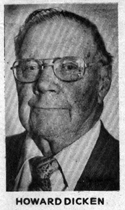
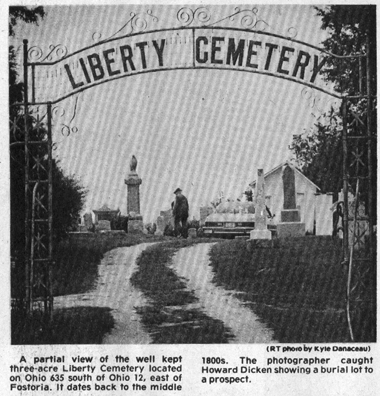
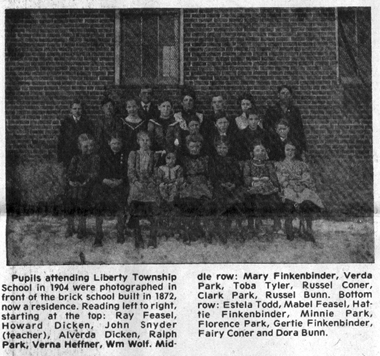
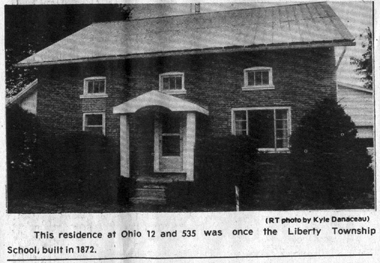
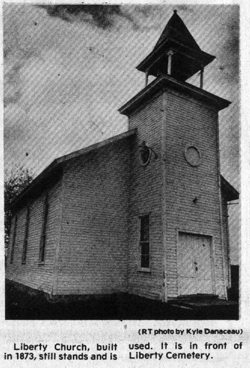
Picture #1 – Howard Dicken
Picture #2 – A partial view of the well kept three-acre Liberty Cemetery located on Ohio 635 south on Ohio 12, east of Fostoria. It dates back to the middle 1800’s. The photographer caught Howard Dicken showing a burial lot to a prospect.
Picture #3 – Pupils attending Liberty Township School in 1904 were photographed in front of the brick school built in 1872, now a residence. Reading left to right, starting at the top: Ray Feasel, Howard Dicken, John Snyder (teacher), Alverda Dicken, Ralph Park, Verna Heffner, Wm Wolf. Middle row: Mary Finkenbinder, Verda Park, Toba Tyler, Russel Coner, Clark Park, Russel Bunn. Bottom row: Estela Todd, Mabel Feasel, Hattie Finkenbinder, Minnie Park, Florence Park, Gertie Finkenbinder, Fairy Coner and Dora Bunn.
Picture #4 – This residence at Ohio 12 and 535 was once the Liberty Township School, built in 1872.
Picture #5 – Liberty Church, built in 1873, still stands and is used. It is in front of Liberty Cemetery.
A cemetery, a church and an old school, which in more recent years was converted to a residence, holds fond memories for Howard Dicken, 866 Eastwood Dr., inasmuch as he has been connected with all three many of his 92 years. On November 10, Mr. Dicken became 93 years “young”.
The accompanying photos show Liberty Cemetery, Liberty Church and the house that was once Liberty School, all located in Liberty Township east of Fostoria. The former school is on Ohio 12 t Ohio 635 and the church and cemetery just south of Ohio 12 on 635.
Back in the early 1800’s, settlers started moving westward into Ohio. One of those was John Thomas and his family, who came to this area from Rochester, N.Y., and settled on 80 acres of land acquired from the U.S. Government. The family consisted of John, his wife, two sons and three daughters. Their first home and barn were log structures, according to the old records kept by Howard Dicken.
The records disclose that regular preaching services were held at the Thomas property as early as 1833 by Samuel Baumgartner, a circuit rider. The Thomas family had been associated with the Evangelical Church in Rochester and through their influence that faith continued in Liberty Township.
People were hungry for the gospel and came from near and far in ox drawn wagons, the records say.
Later, camp meeting also were held on the Peter Erb farm, two miles northeast of Wolf Creek. The Thomas property was still a “preaching place” in 1869, with W.H. Engle being the pastor.
Christian, the one son of John Thomas, later became a minister in the Ohio Conference of the Evangelical Church and the three Thomas girls were all active in the church.
S.E. Rife became pastor in 1870 and services then were held in the Liberty School. It was a frame structure on the same site as the brick structure that later replaced it in 1872 and is shown in the photo.
A program launched by Rife in 1872 to build a church was completed by the next pastor, John Plantz, in 1873. It was dedicated on January 19, of that year by R. Dubbs, editor of “The Batschafter”.
The leading charter members of the church were: Peter Erb, William B. Flack, Amanda Bunn, Isaac Michaels, John Thomas and daughters Mary and Elizabeth, and Mrs. Nancy Wyant. Thomas’s wife Mary died in 1848. Later, leaders in the church were the families of Charles and G.H. Park and James Harrison.
Although the Evangelical Church owned the church building from the time it was constructed for many years, in 1925 the Liberty Township Cemetery Association purchased it. Since 1936, it has been rented by them to various denominations.
LIBERTY CEMETERY
Liberty Cemetery was started on land given by John Thomas at the time of the death of his first wife, she being the first to be buried there. Situated on land higher than the surrounding territory, it was an ideal site with natural drainage.
Howard Dicken has either taken care of or supervised the upkeep of the cemetery for 56 years, beginning when he was a young man of 37. Many of his family are buried there, including his father, mother, sister, two great- grandfathers, an uncle and great aunts and uncles.
Dicken has an accurate record of all of the approximately 1,000 persons buried in the cemetery except one. Many years ago a tramp without identification, was found dead along the road and was buried in the cemetery.
I.W. Dicken, the founder of the photographic studio on Perry Street, which was later taken over by Bill Wonders, was a descendant of the Dickens who lived in Liberty Township and has ancestors buried in the cemetery.
Liberty Cemetery is a beautiful ol rural burial place. It is well kept and the markers appear well preserved, some of them going back to 1840. The day the photos were taken, your author walked through the cemetery and came upon two visitors from Pennsylvania who were looking for a grave marker of a man who was associated with Gen. George Washington during the Revolutionary War and later migrated to this part of Ohio. Their search was fruitless.
LIBERTY CEMETERY ASSOCIATION
As far back as 1873, Liberty Cemetery was governed by an association known as the Liberty Cemetery Association. It originally consisted of Upton Ash, G.W. Ash, J.R. Bunn, George Sour, N.H. Remsburg, John McLaughlin, Edmund R. Ash, William Flack, William Flack, Jr., George Hall, Egbert Dicken and George Woolcott.
Howard Dicken has served as secretary-treasurer of the association since 1926. Earl Ash, deceased, husband of Ethel Rees Ash, served as president for many years up to the time of his death in 1969, when Charles, his son, succeeded him in that office.
Each year the association has a reunion at the church with a carry-in dinner, fellowship and reports. The last one was held October 10. Nelson Grimes is chairman of the reunion committee, Myrta Mosier is secretary and Howard Dicken is treasurer.
LIBERTY SCHOOL
The first formal school for educating the children of the pioneers who settled in Liberty Township was a log structure. According to Howard Dicken, it was built in about 1850 and his grandfather attended there.
The frame-built school that came later was on the same site as the brick structure shown in the photo, and Dicken’s mother attended there and the brick school that followed.
Elmer Feasel and John Long were two of the early school teachers, recalls Dicken. John Long was the great-grandfather of the Longs later resided in Fostoria.
Among Dicken’s collection of historical data and photos is one of the brick schoolhouse that replaced the frame structure in 1872. The photo shows the 21 attendants at the school in 1904 when Howard was 14 years old.
School continued in the brick school until 1920, when it was permanently closed and pupils were than bused to Kansas. Dicken’s records show that Stanley Feasel was the bus driver. He used a canvas-covered truck with a bench on each side for seating. Often, after the truck was used to pick up and take the kids for their return home. Slightly different from today!
Stanley Feasel published a weekly newspaper in Bettsville about the same time he was the school bus driver. The house where he resided stands in a dilapidated condition across the road from the brick residence, once a school.